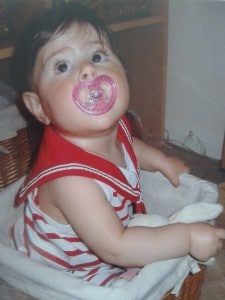When to Introduce a Pacifier to a Breastfeeding Baby
Sucking is a basic instinct that babies are built-in with. Babies suck for both food and comfort. Breastmilk likewise provides protection against disease so nature has made sure that babies honey to exist at the breast. They are comforted past the warmth, smell, delicious milk and reassuring sound of your heartbeat.
Breastfeeding offers a lot of security too, whether your infant is feeling lone, frightened, sad, cross, or ill at ease with a new situation.
In the early days, information technology'due south piece of cake to feel overwhelmed by your baby'south need to nurse. But meeting his needs makes him feel rubber and ensures you have plenty of milk. Equally he grows, your baby's nursing pattern will change and life with your new infant should settle down.
Whenever a substitute for sucking at the breast is used at that place is a take a chance of affecting the breastfeeding relationship, peculiarly for a baby who has not yet mastered nursing at the breast.
Milk product
Breastfeeding problems
Early weaning
Why requite a dummy
Infections
Dental problems
Problems for mother
If breastfeeding is affected
Weaning from a dummy
Breastfeeding, Dummies and SIDS
Milk product
Dummy utilise may reduce your milk product and outcome in poor weight gain. In the early weeks it's really of import to nurse frequently and ensure all sucking is at the breast to institute and maintain good milk production.

Breastfeeding problems
Using a dummy can brand information technology harder for your baby to breastfeed comfortably and effectively (1). The shape and firmer experience of a dummy differs from your pliable chest. Some babies may prefer the stronger sucking trigger of a dummy, leading to 'confusion' nigh how to nurse at the softer breast. The result may be sore nipples for you and not enough milk for your baby. He may become frustrated and offset to fuss, cry or refuse to breastfeed altogether.
Early on weaning
Regular dummy use is associated with premature weaning (ane,2). A dummy is often assumed to be an essential parenting tool. A baby is comforted by sucking, so what could exist more convenient than a small portable device to pop in his mouth? But will offering a dummy cause problems with breastfeeding or can you lot combine the two?
Babies similar to suck for pure pleasure fifty-fifty when milk menstruation slows. You have merely to look at your older baby to run into this—he frequently looks up into your eyes then breaks off sucking to requite yous a great big grin. You lot in turn smile and talk to your infant. These are the first steps in your baby'south evolution of language and relationships.
Why give a dummy?
Information technology's important to remember that a dummy is a substitute for the breast—an object to silence, or pacify a baby's crying until the real matter is bachelor. For this reason information technology doesn't actually make sense for people to suggest a baby is using his mother equally a 'man dummy' when he wants to nurse for comfort.
At that place may be occasions when it's convenient to use a dummy—to calm your baby briefly when yous tin can't nurse him immediately, for instance if you're driving. Sometimes a baby with colic will notice it soothing to suck on a dummy between feeds.
If you lot determine to give your baby a dummy, it's better to wait until breastfeeding is well-established and he is gaining weight well. You will also need to follow manufacturer's guidelines on cleaning and replacement.
In some hospitals premature babies may be given a dummy during tube feeding to stimulate their sucking reflex, help digestion and help them associate the activity of sucking with receiving nutrient. It'southward all-time if this is merely a temporary substitute and efforts are made to plant breastfeeding equally soon as possible.
Infections
Your babe has an increased risk of ear infections if he regularly has a dummy (iii). Thrush tin exist a problem as well, as it thrives on moist surfaces at room temperature.
Dental problems
Breastfeeding provides practice for optimum evolution of a babe's mouth, tongue and jaws and many orthodontists say they encounter fewer dental problems in breastfed babies. Regular dummy use tin touch the growth of teeth and the shape of babies' mouths, increasing the risk of sleep apnoea* and the need for braces later on (4,5). Information technology can also increment the levels of disuse-causing bacteria in babies' mouths (4).
Problems for mothers
Yous can be at risk of engorgement and mastitis when you introduce a dummy—a particular problem if you accept an oversupply of milk. Your periods and fertility may also return earlier equally your hormone levels are affected when your baby nurses less.
Don't forget
Many babies have no interest in using a dummy. You are the best pacifier in the earth from your baby's indicate of view. And what could be more natural than to bring peace to your baby with the warmth of your presence through breastfeeding, rather than with a plastic device.
If breastfeeding is affected
- Terminate using the dummy and so that your baby tin can concentrate on learning to feed well at the chest.
- Offering a breastfeed while he is even so calm and pay extra attending to how he is positioned and attached at the chest.
- Encourage your babe to breastfeed at least 8–12 times in 24 hours, offering both sides and allowing him to nurse for comfort.
- To encourage his interest in breastfeeding hand limited so milk is flowing before offering the breast.
- Ask your LLL Leader nearly the technique of chest compression which has been found to encourage babies to continue breastfeeding actively for longer.
- Spend extra time cuddling, conveying and property your infant, including skin-to-skin contact to help him relax and encourage his interest in breastfeeding.

Weaning from a dummy
Regardless of whether information technology affects breastfeeding, you lot and your infant tin become over-fastened to a dummy. It is easy to find yourself using it more than and more and your toddler's language and social evolution may be delayed. It is recommended that parents end using a dummy once a infant is 6 months old.
You may need to wean yourself from the convenience of popping in the dummy when your babe fusses and give extra attending, cuddling or nursing instead.
To reduce or cut out dummy use, endeavour:
- Offering to nurse instead.
- Restricting your baby's dummy use to certain times such as only in the car.
- Carrying him, taking him for a walk in the buggy, giving him a bath, playing games, singing or sharing other interesting activities.
If your baby has get accepted to falling asleep with a dummy, the simplest choice is to breastfeed him instead. From half dozen months:
- Try gently removing the dummy once he is asleep or very sleepy so that he gradually learns to fall asleep without it.
- Keep trying equally new slumber associations take a while to establish. Yous could introduce other sleep cues such as wrapping in a blanket, rubbing his dorsum, rocking and/or a key give-and-take, for case 'shh'.
Extra time focussing on your infant'due south needs whilst working to reduce dummy use will help the change go more smoothly. If you have any questions or need back up as you wean your babe from using a dummy you tin contact an LLL Leader by calling our Helpline. You can find your local group here.

Breastfeeding, Dummies and SIDS
Some research has shown that using a dummy to settle a baby to slumber tin can reduce the take chances of sudden infant expiry syndrome (SIDS) (6,7). The cause and effect is unknown, and may be related to other protective factors. Information technology is possible that a baby falling comatose with a dummy mimics babies falling asleep at the breast (8,nine) Babies mostly go along a dummy in the oral cavity for less than fifteen minutes at slumber times (x)—similar to the fourth dimension information technology takes a infant to breastfeed to slumber.
Current recommendations for dummy employ at sleep times (6,xi) are that a dummy should:
- Non exist used to replace breastfeeding.
- Not exist replaced after a baby falls asleep.
- Non be given to a baby who doesn't want it.
It would seem from these recommendations, that a babe who breastfeeds to sleep is unlikely to desire or demand a dummy.
*Slumber apnoea: irregular breathing during sleep.
Further Reading
Beginning Breastfeeding
My Baby Needs More Milk
Nipple Confusion?
Safe Sleep & The Breastfed Baby
Sleepy Baby – Why & What To Do
Books
The Womanly Art of Breastfeeding, LLLI. London: Pinter & Martin, 2010.
References
- Righard, L and Alade, M. Breastfeeding and the use of pacifiers. Nascence 1997; 24(2): 116-20.
- Victoria, C et al. Pacifier use and short breastfeeding elapsing. Cause, Consequence or Coincidence. Pediatrics 1997; 99(3): 445-453.
- Warren, JJ et al. Pacifier apply and the occurrence of otitis media in the commencement yr of life. Pediatric Dentistry 2001; 23(ii): 103-07.
- Palmer, B. Breastfeeding: Reducing the Chance for Obstructive Slumber Apnea. Breastfeeding Abstracts. 1999 Feb xviii(iii): 19-20.
- Viggiano, D, et al. Breastfeeding, bottlefeeding, and non-nutritive sucking: Furnishings on occlusion in deciduous dentition. Curvation Dis Child 2005; 89: 1121-23.
- Hauck, FR et al. Practise pacifiers reduce the risk of sudden infant death syndrome? A meta-analysis. Pediatrics. 2005 Nov; 116(five): e716-23.
- Li, DK et al. Use of a dummy (pacifier) during slumber and take a chance of sudden infant death syndrome (SIDS): population based casecontrol study. BMJ 2006 January 7; 332(7532): 18-22.
- Blair, PS and Fleming, PJ. Dummies and SIDS: Causality has non been established. BMJ 2006; 332: 178.
- Fleming, PJ et al. Pacifier use and sudden infant death syndrome: results from the CESDI/SUDI case control written report .CESDI SUDI inquiry squad. Arch Dis Child 1999; 81: 112-6.
- Weiss, P and Kerbl, R. The relatively curt duration that a child retains a pacifier in the oral cavity during slumber: implications for sudden infant decease syndrome. Eur J Pediatr. 2001; 160: 60-70.
- Moon, RY et al. Sudden baby expiry syndrome. Lancet. 2007 Nov 3; 370(9598): 1578-87.
- NICE Clinical Guideline CG 37: Postnatal intendance: Postnatal care up to 8 weeks later on nativity National Collaborating
- Centre for Main Care and Imperial College of General Practitioners, 2006. http://www.dainty.org.britain/guidance/cg37/chapter/ane-recommendations#infant-feeding http://www.prissy.org.uk/CG037
This information is bachelor to purchase in printed form from the LLLGB Shop
Source: https://www.laleche.org.uk/dummies-and-breastfeeding/
0 Response to "When to Introduce a Pacifier to a Breastfeeding Baby"
Post a Comment